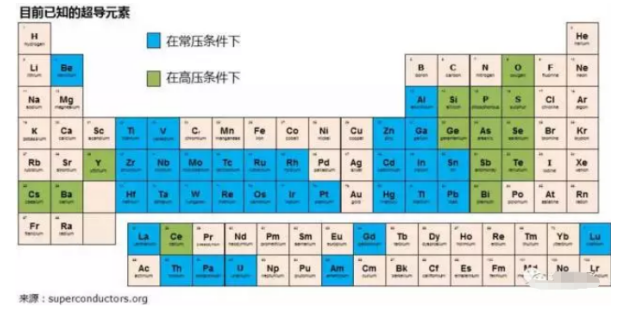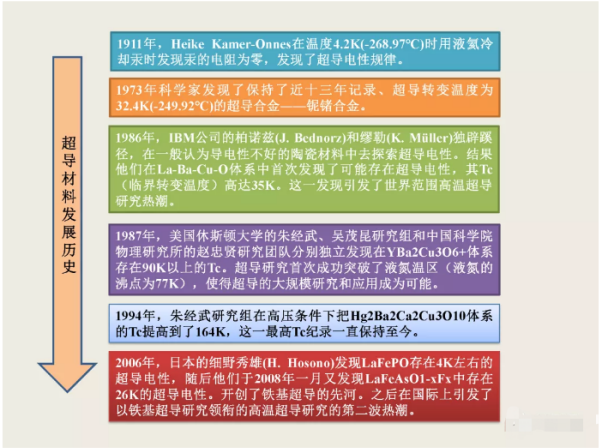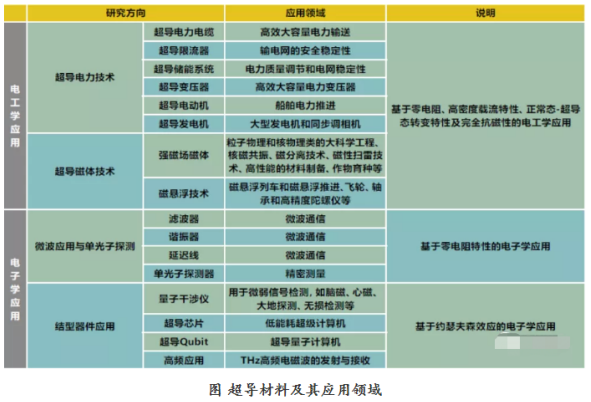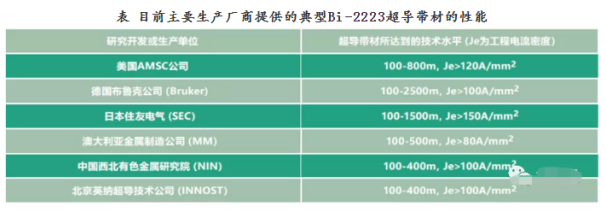Detailed knowledge of metal, Superconductor classification and its applications
Release time:2022-02-16Click:973
Any conductor has a certain resistance at room temperature. However, when certain room-temperature metals, such as lead, tin, and niobium, are cooled to a certain extreme low temperature, the resistance at the two ends of the metal suddenly disappears to zero, that’s the loss of any resistance, and that’s the superconducting effect. The cryogenic Superconductor classification has a low superconducting transition temperature (TC < 30K) and can operate at liquid helium temperature. The fundamental properties of superconductors include the zero resistance effect, the Meissner effect effect, and the Brian David Josephson effect. So far, 46 elements (32 at atmospheric pressure and 14 at high pressure) and thousands of alloys and compounds have been found to be Superconductor classification.



Superconductors not only have zero resistance in critical point, but also have electromagnetic properties that conventional conductors do not have under certain conditions, so they have wide applications in the field of electrical and electronic engineering. China is generally in the international advanced ranks in the field of Superconductor classification and its applications, basically mastered a variety of practical Superconductor classification preparation technology, in a number of applications have also made good development. The Superconductor classification and its applications will continue to explore critical point superconductors to upgrade the Superconductor classification and its application technology.

Over 100 years of research, tens of thousands of superconductors have been discovered. According to the critical point of the superconductor, the superconductor can be divided into the cryogenic superconductor and the High-temperature superconductivity, the critical point superconductor is the cryogenic superconductor and the critical point superconductor is the High-temperature superconductivity. Currently, low-temperature Superconductor classification applications operate at liquid helium temperatures (4.2 k and below) and high-temperature Superconductor classification applications operate between liquid hydrogen temperatures (about 20K) and liquid nitrogen temperatures (about 77K) . The Superconductor classification has discovered tens of thousands of superconductors, but not many of them are of practical use. At present, the low temperature superconductors applied mainly include NBTI, Nb3Sn, NB3AL, etc. . The High-temperature superconductivity with practical value mainly include:
Bismuth series (BSCCO, TC about 90K-110K, also known as the first generation of high temperature Superconductor classification, mainly including BSCCO-2212 and BSCCO-2223, also known as BI-2212 or BI-2223) . YTTRIUM system (TC ABOUT 90K, YBCO or Rebco, also known as second generation Superconductor classification). In the 21st century, MGB2(TC = 39K) and Iron-based superconductor (TC = 55K) have been discovered and become two new superconductors with practical application potential. The present situation and prospect of Superconductor classification include NBTI, NB3SN, NB3AL and so on. Since the 1960s, its preparation technology and technology has been quite mature, and has promoted the development of such as accelerator magnets, superconducting magnets for nuclear fusion engineering, nuclear magnetic resonance (MRI and n) magnets, general superconducting magnets, etc. , and formed a certain scale of superconducting industry. At present, the United States, the European Union and Japan and other countries and regions have a large number of enterprises can produce a variety of low temperature Superconductor classification for different application needs. In 2006, China joined the International Thermonuclear Fusion Experimental Reactor (ITER) program, which opened up unprecedented opportunities for the development of China’s low temperature Superconductor classification. The ITER project has greatly promoted the development of low temperature Superconductor classification in China, and has also provided the Superconductor classification for the independent development of MRI, accelerator and nuclear fusion magnets in China.
Despite the challenges posed by the development of high temperature Superconductor classification, there is no substitute for the advantages of low temperature Superconductor classification in terms of batch processing technology, cost, and operational stability. With the development of refrigeration technology, the dependence of cryogenic superconducting devices on liquid helium is gradually reduced, and cryogenic Superconductor classification will remain the most important material in superconducting industry for a long time to come. As the performance level and process line of the cryogenic Superconductor classification are already quite mature, the international competition mainly comes from the competition of price performance. China Western Superconductor Technology Co. , Ltd. has already formed its own competitive advantage in the production of low temperature Superconductor classification, and will continuously optimize the process and improve the performance level of the materials according to the application demand in the future, especially around China Fusion Engineering Experimental Reactor (CFETR) , Super Proton Collider (SPPC) and domestic MRI market development demand, to form a production capacity matching domestic demand. Low temperature Superconductor classification has also been proposed as a focus for the development of new materials at the fifteen forward looking layout frontier.
Development Status and prospect of high temperature Superconductor classification ● BI series high temperature Superconductor classification ● since the end of last century, the fabrication technology of Bi-2223 superconducting tapes has become increasingly mature. AMSC (AMSC) , INNOST (Beijing) , Bruker (Germany) , Sumi Tomo (Japan) and many other companies have the ability to mass-produce kilometer-long tape. In 2006, Sumitomo Electric Corporation of Japan set up a 30 MPA cold wall type Cont roll Ed Over Pressur e (CT-OP) heat treatment scheme, and successfully prepared a strip with a critical current up to 150A. At present, Sumitomo Electric has been able to produce critical current up to 200A kms level Bi-2223 superconducting tape, this is the highest level reached by BI-2223 at present. Up to now, the total annual production capacity of Bi-2223 tapes has reached more than 1000 kilometers, which has laid a solid foundation for the development of hts power application technology. The following table shows the performance of superconducting tapes supplied by Major Bi-2223 suppliers at home and abroad.

In recent years, more attention has been paid to YBCO (or REBCO) superconductors because of their superior performance in magnetic field compared with BI-2223. The irreversible field of YBCO AT 77K is up to 7t, which is one order of magnitude higher than BI-2223. Weak connection is the main obstacle to obtain high-performance second-generation high-tc superconducting (y) tapes. The Grain Boundary Angle between the adjacent YBCO grains is the key to determine whether the superconductor can carry large current without resistance. In addition, since the YBCO current travels mainly in the a-b plane, the YBCO layer with strong cubic texture perpendicular to the substrate surface must be fabricated on the flexible metal substrate in order to obtain the high performance second generation hts tapes. In order to obtain the long-scale and strong cubic texture, the epitaxial growth of YBCO superconducting tape is usually carried out by coating technique.
Iron-based Superconductor classification like Bi-2223, iron-based superconducting tapes are generally prepared by the PIT method. At present, at home and abroad, the main research units are the Institute of Electrotechnics of Chinese Academy of Sciences, Florida State University, Japan National Institute of Materials, Tokyo University, University of Genoa, Japan Industrial Technology Institute, University of Wollongong, etc. . The Institute of Electrotechnics of the Chinese Academy of Sciences has been leading the world in the development of high performance iron based Superconductor classification. In 2014, the Institute of Electrical Engineering of the Chinese Academy of Sciences raised the critical current density of iron-based superconducting wires to 105A/cm2(4.2 k, 10T) for the first time, reaching a practical level. In addition, the key technologies involved in the preparation process, such as the control of phase composition and microstructure, and the uniform processing of interface complex, are systematically studied, the technical difficulties of uniformity, stability and repeatability in large-scale preparation of iron-based superconductors were solved, and 7-core iron-based 100-meter long wires with length up to 115 m were successfully prepared in 2016(as shown in the figure below) , the work has been hailed as a milestone in the Superconductor classification’s transition from laboratory research to industrialization, laying the foundation for Superconductor classification’s applications in industry, medicine, national defense and many other fields. Current status and prospect of superconducting application technology
Current-carrying capacity of superconducting wire can reach 100 ~ 1000A/mm2(about 50 ~ 500 times of current-carrying capacity of ordinary copper wire or aluminum wire) , and its transmission loss is zero in DC state, therefore, the power equipment made of superconductor has the advantages of low loss, high efficiency and small space occupation. Because the superconductor loses superconductivity when the current exceeds its critical current, it presents a higher resistivity, therefore, the current limiting device (FCL) made of superconducting wire can automatically limit the rise of the short-circuit current when the short-circuit fault occurs in the power network, thus effectively protect the safe and stable operation of the power network. In addition, the superconducting energy storage system (SMES) developed by using superconducting wires is an efficient energy storage system (the efficiency can reach more than 95%) , and has the characteristics of fast high power response and flexible control, it also has potential application value for solving the problem of power system security and stability and transient power balance. The main challenge is whether the cost performance of Superconductor classification can be similar to traditional conductive materials, cryogenic refrigeration system can be long-term operational reliability and stability. In particular, large scale applications of superconducting power technology will become a reality if higher critical point superconductors, and even Room-temperature superconductor, can be explored, and if such new superconductors have good electromagnetic properties.
Development status and prospect of superconducting magnet technology high magnetic field condition is helpful to realize special function and discover new physical phenomenon, so it has important application value in modern science and technology. Since the 1960s, with the discovery of practical low temperature Superconductor classification, superconducting magnet technology has been greatly developed and widely used in nuclear magnetic resonance, large scientific engineering, scientific instruments and industrial equipment, etc. , and has become a very mature technology. High Energy Accelerator is one of the most important fields of superconducting magnets in large science projects, such as the LHC in Europe, the RHIC in the United States and the DESY and GSI in Germany. The Institute of High Energy Physics of Chinese Academy of Sciences, Lanzhou Institute of Modern Physics, Institute of Plasma of Chinese Academy of Sciences and Shanghai Institute of Applied Physics have also carried out a series of research and development around ADS and high energy detectors. In the field of nuclear fusion, Tokamak, Stellarator, and mirror machines, as well as the suspended plasma facility (LDX) , also require superconducting magnets.
The main challenge is to develop superconducting magnets (9.4 t or above, 800 mm) for large aperture high field magnetic resonance imagin systems, superconducting magnets for nuclear magnetic resonance spectrometers with magnetic field strength of 25 T or above, and superconducting magnets (30 T or above) for high field applications. The development of these special superconducting magnets is of great significance to the understanding of the structure and activity law of matter and life. The applications of superconducting electronics mainly include microwave communication applications, Brian David Josephson junction applications and single photon detection, etc. . Unlike the above superconducting power technology and superconducting magnet technology applications, superconducting electronics applications are mainly based on superconducting thin film materials and superconducting nanowires and Superconductor classification. At present, superconducting thin films (such as NB and YBCO) have been prepared by mature technology, and the laboratory preparation of superconducting thin films has become the basic experimental means of superconducting physics.
Source: Caitong
Disclaimer: Some pictures and texts on this site are collected from the Internet and are only for learning and communication. The copyright belongs to the original author and does not represent the views of our site. This site will not bear any legal responsibility. If your rights are violated, please contact us to delete it in time.


